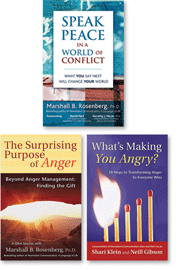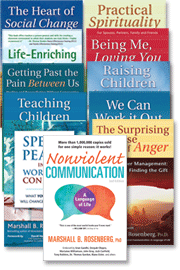Shared Vision... continued
One clear example is the 1930 Salt march. In response to a law forbidding Indians to make their own salt, Gandhi led a march to the sea to claim the free salt. This wasn't a boycott; it was a clear focus on self-sufficiency and independence, with a strong message of removing the legitimacy of British rule ( Gandhi the Man , p. 70).
Another example is from the Civil Rights Movement which was profoundly inspired by Gandhi's example. The young activists actively challenged segregation. In choosing to enter and sit at lunch counters together across racial divisions, they implemented their vision of a world in which racial barriers are removed, which goes beyond an act of protest.
Noncooperation in the form of civil disobedience was only one component of Gandhi's scheme. He saw the struggle for independence as made up of both what Michael Nagler calls "Obstructive Programme" and a detailed Constructive Programme. The role of Obstructive Programme was to interfere with the British rulers' ability to carry out their control of the nation. The role of Constructive Programme was to create the material and social infrastructure that would provide the foundation for the future society.
Although a full exploration of Gandhi's programs is beyond the scope of this article, some points are particularly relevant, especially the importance that Gandhi assigned to the constructive side of the work towards independence. He maintained, in fact,
"… that Civil Disobedience is not absolutely necessary to win freedom through purely non-violent effort, if the co-operation of the whole nation is secured in the Constructive Programme. But such good luck rarely favours nations or individuals. Therefore, it is necessary to know the place of Civil Disobedience in a nation-wide non-violent effort." ( Constructive programme: Its meaning and place, 1941). *1
Gandhi's program had eighteen elements in it, including abolishing untouchability, establishing gender equality, what he called village uplift, and achieving economic equality. At its heart was the freeing of India from the imposed economic dependence on the British through the means of re-learning the ancient art of weaving cotton. In some ways Gandhi saw this aspect of the program as the most essential. When asked in 1940 "What will it really take to get the British off our backs?" his response was: "Phenomenal progress in spinning." ( Search for a Nonviolent Future, p. 177) He saw "Constructive programme [as] a Solar System and the charkha [spinning wheel] [as] the Sun". ( Search for a Nonviolent Future, p. 183)
To my knowledge, a coherent constructive program has not emerged for current nonviolent social movements who identify as such, and their work is primarily focused on obstruction, with a more narrow focus on protest than Gandhi or Martin Luther King, Jr. applied to their work. *2 Specifically, what is missing for a constructive program is a core activity with a role similar to that of spinning in Gandhi's days. That role is threefold: an activity that produces concrete material results, that is essential for creating the future, and that anyone can undertake. *3
This principle of nonviolence – the focus on what we want to create, not just what we oppose – is not as widely known as others despite being so foundational to Gandhi's way of thinking and acting.
This principle is also fundamental to the practice of NVC. If others' actions – individuals, groups, or institutions – are to our liking, we can move towards what we want by waking up to celebration and gratitude. At all times, we can move towards what we want by initiating and sustaining actions and projects grounded in our deepest vision. Then we are more prepared to maintain our nonviolence by remembering and staying grounded in what we want when people are doing things we don't like. Knowing what we are working towards allows us to bring all the love we have to our actions and act with care for others' well-being.
Just as much as constructive program is often absent from social change movements, in daily life more often than not we focus on trying to stop or move away from what's not working rather than reflect and connect with ourselves sufficiently to know what is important to us, what we really want, and move towards it by engaging the other party in dialogue.
Indeed, perhaps the heart of the practice of NVC revolves around understanding our needs, being able to get to sufficient connection with ourselves to know what matters to us on the most fundamental human level. Once we know the needs, we can then consider what strategies can help meet those needs, and make requests of others to increase the chances of having our needs met. It is through understanding the needs that we move from opposing others or giving up to engaging in dialogue towards creating mutually beneficial solutions.
The last segment of this 7-part series explores the 7th principle that NVC shares with Ghandian nonviolence: the recognition that nonviolence requires an ongoing inner practice that grounds all external choices.
The complete bibliography for the series can be found online at NVC Gandhian Principles Bibliography. Part 3 of this series contained a link to the worksheet:
Practice: Transforming Judgments and Enemy Images
Miki Kashtan is a co-founder of Bay Area Nonviolent Communication. She leads workshops and intensive retreats in Nonviolent Communication throughout the United States and in Japan, Europe, Brazil, and Africa, and offers mediation, meeting facilitation, coaching, and training for organizations. Miki hosts the Conflict Hotline, a monthly live call-in TV show, and blogs regularly at The Fearless Heart. She holds a Ph.D. in Sociology from UC Berkeley and her articles have appeared in Tikkun magazine and elsewhere.
*1 See also a fuller description by M. K. Gandhi in: CONSTRUCTIVE PROGRAMME
It's Meaning and Place
*2 There are hundreds of movements, communities, groups, and individuals who are participating in creating an alternative future through multiple actions such as different forms of education, providing free health care, permaculture and other forms of sustainable food growing, alternative energy, climate change work, and many many others. At present, I don't see any of these as forming a coherent, self-aware constructive program rather than a collection of uncoordinated actions.
*3 Some potential candidates that are being explored by nonviolence advocates are food growing, silence, and transforming human relations. A discussion of these emerging directions for constructive program would go beyond the scope of this article.
Keep learning these vital communication skills with these books and training resources:
This Month's Specials:
- NVC Anger Management Book Package - Save 50% off list price through July 31, 2011
- Marshall Rosenberg Book Package - Save 55% off list price through July 31, 2011
Every Day Book Package Specials:
- NVC Starter Kit Book Package - Save 40% - 50% on this book package every day from PuddleDancer Press
- NVC Reference Library Package - Save 50% - 60% on this book package every day from PuddleDancer Press






